疾病相关营养不良评估股直肌性别特异性超声阈值:横断面分析
IF 3
3区 医学
Q2 NUTRITION & DIETETICS
引用次数: 0
摘要
目的:疾病相关营养不良(DRM)经常导致肌肉质量和功能的丧失,增加发病率和死亡率的风险。营养超声是一种很有前途的、无创的评估肌肉成分的工具;然而,诊断肌萎缩症的性别特异性临界值仍不清楚。背景:在这项回顾性横断面研究中,我们使用GLIM标准评估成人DRM患者。获得股直肌(RF)超声测量(厚度、宽度、横截面积[CSA])和生物电阻抗分析(BIA)。通过握力评估肌肉功能。受试者工作特征(ROC)曲线确定了肌萎缩症的性别特异性超声阈值。结果:84例患者,平均年龄65.6岁,男性占57.1%。低ASMI患者中有53.6%存在近视。男性的最佳射频阈值分别为11.45 mm(厚度)、36.95 mm(宽度)和2.92 cm²(CSA);雌性分别为9.40 mm、34.55 mm和2.30 cm²。降低的RF值与较低的相位角、体细胞质量和握力显著相关。结论:本研究为DRM患者的股直肌评估提出了新的、性别特异性的超声阈值。研究结果支持超声在形态功能评估框架内作为一种无创的、可获得的诊断肌萎缩的方法。本文章由计算机程序翻译,如有差异,请以英文原文为准。
Sex-specific ultrasound thresholds of rectus femoris assessment in disease-related malnutrition: A cross-sectional analysis
Objectives
Disease-related malnutrition (DRM) frequently results in loss of muscle mass and function, increasing morbidity and mortality risk. Nutritional ultrasound is a promising, noninvasive tool for assessing muscle composition; however, sex-specific cut-off values for diagnosing myopenia remain unclear.
Background
In this retrospective cross-sectional study, we evaluated adult DRM patients using the GLIM criteria. Rectus femoris (RF) ultrasound measurements (thickness, width, cross-sectional area [CSA]) and bioelectrical impedance analysis (BIA) were obtained. Muscle function was assessed via handgrip strength. Receiver operating characteristic (ROC) curves identified sex-specific ultrasound thresholds for myopenia.
Results
Eighty-four patients (mean age: 65.6 years; 57.1% male) were analyzed. Myopenia was present in 53.6% based on low ASMI. Optimal RF thresholds for males were 11.45 mm (thickness), 36.95 mm (width), and 2.92 cm² (CSA); for females, 9.40 mm, 34.55 mm, and 2.30 cm², respectively. Reduced RF values were significantly associated with lower phase angle, body cell mass, and handgrip strength.
Conclusions
This study proposes novel, sex-specific ultrasound thresholds for rectus femoris assessment in DRM patients. Findings support ultrasound’s role as a noninvasive, accessible method for diagnosing myopenia within a morphofunctional evaluation framework.
求助全文
通过发布文献求助,成功后即可免费获取论文全文。
去求助
来源期刊

Nutrition
医学-营养学
CiteScore
7.80
自引率
2.30%
发文量
300
审稿时长
60 days
期刊介绍:
Nutrition has an open access mirror journal Nutrition: X, sharing the same aims and scope, editorial team, submission system and rigorous peer review.
Founded by Michael M. Meguid in the early 1980''s, Nutrition presents advances in nutrition research and science, informs its readers on new and advancing technologies and data in clinical nutrition practice, encourages the application of outcomes research and meta-analyses to problems in patient-related nutrition; and seeks to help clarify and set the research, policy and practice agenda for nutrition science to enhance human well-being in the years ahead.
 求助内容:
求助内容: 应助结果提醒方式:
应助结果提醒方式:


